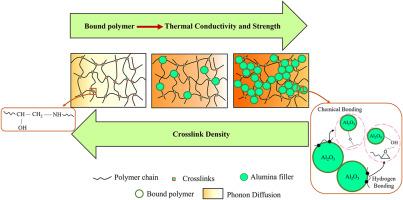From Molecular Mobility to Phonon Transport: Mechanistic Insights into Thermally Conductive Epoxy–Alumina Adhesives
IF 4.5
2区 化学
Q2 POLYMER SCIENCE
引用次数: 0
Abstract
This study investigates the mechanisms involved in designing thermally conductive adhesives based on epoxy resin and alumina microparticles. Both the presence of fillers and the chemical crosslink density (CLD) influence the final properties of the cured resins. Therefore, the contributions of these two factors are examined by studying the curing kinetics of the systems. The results indicate that while alumina particles can promote the curing reaction through the chemical contribution of surface hydroxyl groups, the interactions between polymer chains and microparticles can slow down the curing kinetics—particularly due to the formation of an interconnected network at high filler contents, which reduces the molecular mobility of the system and leads to lower final CLD values. Additionally, enhanced phonon diffusion—primarily due to the development of the filler network—significantly increases thermal conductivity (TC) beyond a filler content of 30 wt.%, consistent with the rheological percolation threshold. Finally, the high TC induced by conductive fillers, combined with their effect on reducing the chemical CLD, increases the thermal sensitivity of the composites. Further investigations reveal that the filler particles also influence the final strength by facilitating stress concentration.

从分子迁移到声子传输:对导热环氧-氧化铝胶粘剂的机械见解
本研究探讨了基于环氧树脂和氧化铝微粒的导热胶粘剂的设计机制。填料的存在和化学交联密度(CLD)都会影响固化树脂的最终性能。因此,通过研究体系的固化动力学来检验这两个因素的贡献。结果表明,虽然氧化铝颗粒可以通过表面羟基的化学贡献促进固化反应,但聚合物链和微颗粒之间的相互作用会减缓固化动力学,特别是在高填料含量时形成相互连接的网络,这降低了体系的分子迁移率,导致最终CLD值降低。此外,增强的声子扩散——主要是由于填料网络的发展——在填料含量超过30wt .%时,显著增加了导热系数(TC),与流变渗透阈值一致。最后,导电填料引起的高TC,结合其降低化学CLD的作用,增加了复合材料的热敏性。进一步的研究表明,填料颗粒也通过促进应力集中而影响最终强度。
本文章由计算机程序翻译,如有差异,请以英文原文为准。
求助全文
约1分钟内获得全文
求助全文
来源期刊

Polymer
化学-高分子科学
CiteScore
7.90
自引率
8.70%
发文量
959
审稿时长
32 days
期刊介绍:
Polymer is an interdisciplinary journal dedicated to publishing innovative and significant advances in Polymer Physics, Chemistry and Technology. We welcome submissions on polymer hybrids, nanocomposites, characterisation and self-assembly. Polymer also publishes work on the technological application of polymers in energy and optoelectronics.
The main scope is covered but not limited to the following core areas:
Polymer Materials
Nanocomposites and hybrid nanomaterials
Polymer blends, films, fibres, networks and porous materials
Physical Characterization
Characterisation, modelling and simulation* of molecular and materials properties in bulk, solution, and thin films
Polymer Engineering
Advanced multiscale processing methods
Polymer Synthesis, Modification and Self-assembly
Including designer polymer architectures, mechanisms and kinetics, and supramolecular polymerization
Technological Applications
Polymers for energy generation and storage
Polymer membranes for separation technology
Polymers for opto- and microelectronics.
 求助内容:
求助内容: 应助结果提醒方式:
应助结果提醒方式:


